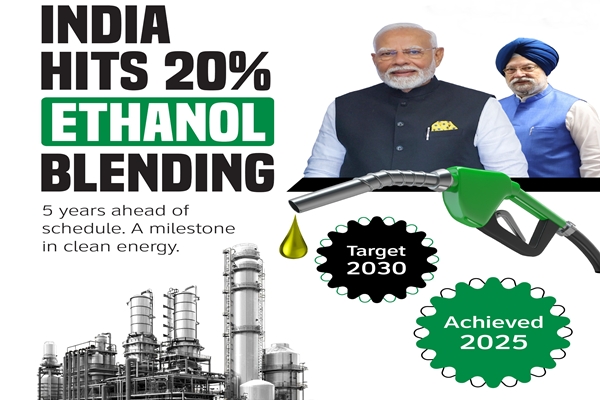India’s Ethanol Blending Success

- 26 Jul 2025
In News:
India has achieved a significant milestone by reaching 20% ethanol blending in petrol by March 2025, five years ahead of the original 2030 target under the National Policy on Biofuels (2018). This landmark achievement represents a transformative step in India’s journey toward energy self-reliance, environmental sustainability, and inclusive rural development.
Genesis and Policy Framework
The Ethanol Blended Petrol (EBP) Programme, launched in 2003 and significantly scaled up post-2014, aims to reduce dependence on imported crude oil, promote clean fuels, and support the agricultural economy. The programme is spearheaded by the Ministry of Petroleum and Natural Gas in collaboration with the Ministries of Agriculture and Food Processing. The National Policy on Biofuels expanded the permissible feedstocks for ethanol production, including sugarcane juice, B-molasses, damaged grains, maize, and agricultural residues.
Complementary initiatives like PM-JI-VAN Yojana, SATAT, PLI for ethanol production, and the National Bio-Energy Programme have accelerated infrastructure creation and second-generation (2G) ethanol technologies.
Progress and Scaling
The ethanol blending rate rose from 1.53% in 2014 to 8.17% in 2020–21, then to 12.06% in 2022–23, and reached 14.6% in 2023–24, culminating in the 20% target in early 2025. This scaling was supported by ?40,000 crore in investments and proactive procurement by Oil Marketing Companies (OMCs) at pre-fixed prices, providing market stability for distilleries and farmers.
Over 17,000 fuel retail outlets now offer E20 fuel, with 400 E100 pumps operational. Automakers such as Honda and Hero MotoCorp have ensured vehicle compatibility with E20 fuels, ensuring consumer acceptance.
Economic and Rural Impact
The EBP programme has delivered strong macroeconomic and grassroots benefits. By reducing crude oil imports, India has saved substantial foreign exchange and improved energy security. At the micro level, farmers—particularly sugarcane and maize growers—have benefited from assured off-take and stable prices, reducing rural distress and boosting income security.
Moreover, the ethanol ecosystem has generated rural employment, supported local manufacturing under ‘Make in India’, and catalyzed investment in agro-industrial infrastructure.
Environmental and Climate Gains
India’s ethanol blending drive aligns with its climate commitments, especially its Net Zero by 2070 target. Ethanol blending has helped avoid 698 lakh tonnes of CO? emissions, reduced particulate pollution, and improved urban air quality. The shift also supports circular economy principles by utilizing agricultural surplus, foodgrains unfit for consumption, and residues—converting waste to wealth.
Future strategies emphasize 2G ethanol from non-food biomass and municipal waste, thereby reducing land and water stress associated with first-generation biofuels. Advanced technologies like lignocellulosic processing, sustainable aviation fuel (SAF), and ethanol-to-hydrogen conversion are in focus.
Conclusion
India’s early achievement of 20% ethanol blending demonstrates the success of coordinated policymaking, technological adoption, and stakeholder alignment. It serves as a model of how energy policy can intersect with rural prosperity, environmental stewardship, and industrial growth. Going forward, India’s biofuel roadmap not only reinforces its clean energy leadership but also strengthens its resolve for energy Atmanirbharta, sustainable development, and climate resilience.
